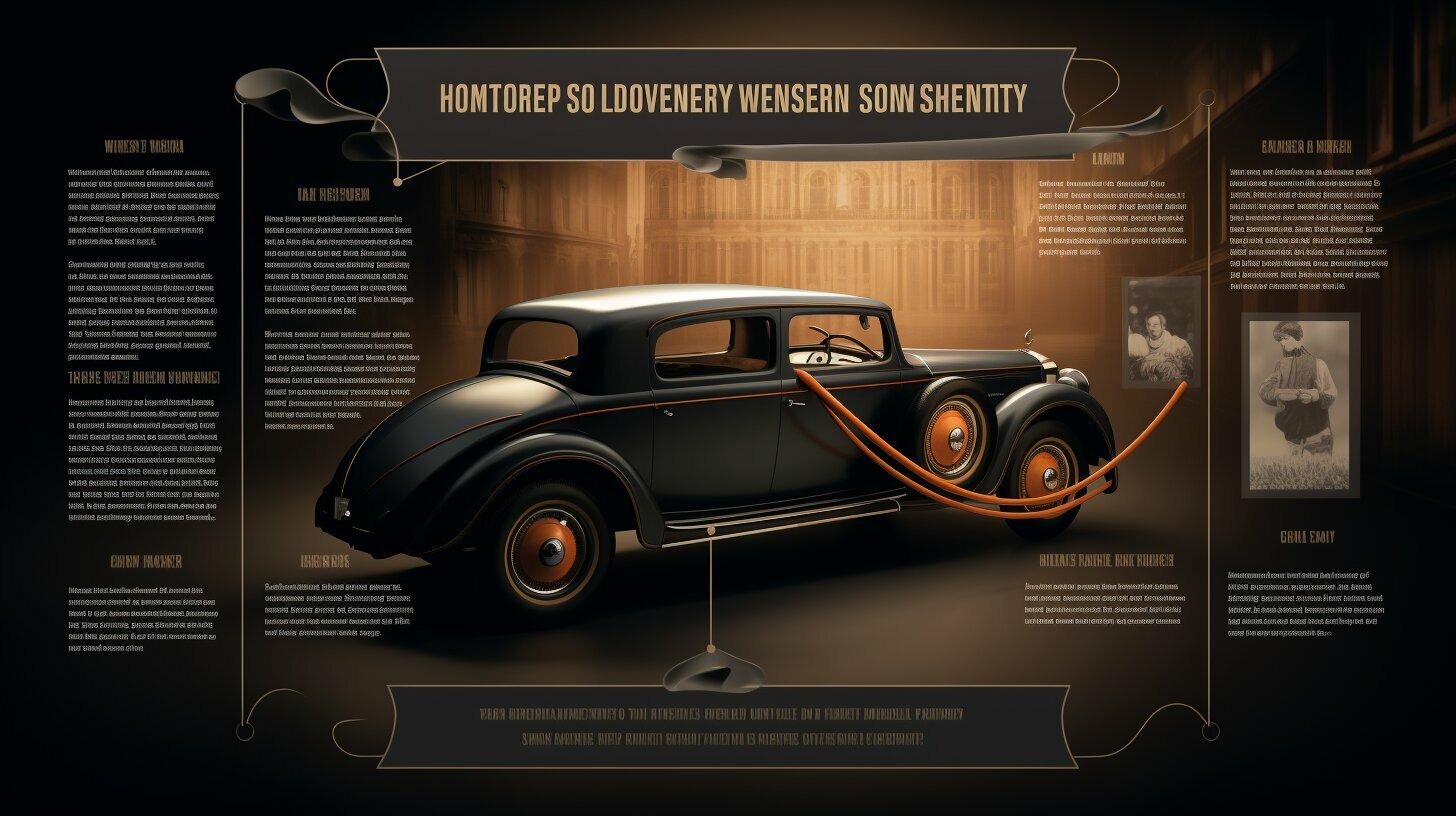Unveiling the Mystery: Why Are Suicide Doors Called Suicide Doors?
Suicide doors have long intrigued car enthusiasts and history buffs alike, but have you ever wondered why they are called “suicide doors”? In this article, I will take you on a journey through the fascinating origins and history of these unique automotive features.
Key Takeaways:
- Suicide doors, also known as rear-hinged doors, swing outward from the vehicle’s rear.
- The term “suicide doors” came about due to the safety risks they presented, such as passengers falling out while the vehicle was in motion.
- Many countries outlawed suicide doors or mandated additional safety measures as car safety regulations became more stringent.
- Despite safety concerns, suicide doors remain popular among luxury car manufacturers and automobile enthusiasts.
- Exercise caution when using cars with suicide doors, as they still pose safety risks.
The Early Days: An Automotive Revolution
Before we uncover the reason behind the morbid name, let’s dive into the early days of suicide doors and their unique design. Suicide doors, also known as rear-hinged doors, made their debut in the early 20th century and quickly became a symbol of automotive innovation. These doors, which swing outward from the rear, offered a revolutionary departure from the conventional front-hinged doors. The distinctive design not only caught the attention of car enthusiasts but also provided practical benefits.
One of the main advantages of suicide doors was the ease of access they offered. With a wider opening and no center pillar obstructing entry, passengers could effortlessly slide in and out of the vehicle. This feature was especially appealing to those sporting elegant attire, as it allowed for graceful entrances and exits without the need to compromise style. Additionally, the rear-hinged design added a touch of sophistication, elevating the aesthetic appeal of luxury automobiles.
However, it is important to note that the introduction of suicide doors also brought about safety concerns. Given that these doors opened in the opposite direction from standard doors, passengers were at a greater risk of accidentally falling out of the vehicle while it was in motion. In the event of an accident, rescuers faced difficulties in freeing individuals confined within the car due to the unconventional door configuration. These safety issues would ultimately lead to significant controversies surrounding the use of suicide doors in the automotive industry.
| Safety Concerns | Benefits |
|---|---|
|
|
As car safety regulations became more stringent, many countries introduced laws that either outlawed suicide doors altogether or required additional safety measures to mitigate the associated risks. Seat belts and warning labels became mandatory additions to vehicles with suicide doors, ensuring passenger safety and raising awareness about the potential hazards.
Despite the safety concerns surrounding suicide doors, their unique appeal has persisted in the automotive industry. Luxury car manufacturers and enthusiasts continue to embrace this distinctive design element for its aesthetic value, practicality, and cultural allure. Iconic models such as the Rolls-Royce Phantom and Mazda RX-8 showcase the enduring charm of suicide doors.
Safety Measures for Suicide Doors
It is crucial to exercise caution when using cars with suicide doors to ensure the safety of both passengers and pedestrians. Manufacturers have implemented various safety measures to address the risks associated with these doors. These measures include reinforced door structures, advanced locking systems, and proximity sensors that prevent the doors from opening when the vehicle is in motion. These advancements aim to mitigate the potential dangers and ensure a safer experience for all.
Safety Risks and Controversies
While suicide doors have undoubtedly made a mark in automotive history, their design has faced significant safety concerns and sparked controversies. These unique rear-hinged doors, which swing outward from the vehicle’s rear, have captured attention for their unconventional style and practicality. However, their unconventional nature comes with inherent safety risks that have raised eyebrows and prompted regulatory actions.
“Suicide doors were named as such due to the potential danger they posed to passengers. Opening in the opposite direction from standard doors, they made it easier for passengers to accidentally tumble out of the vehicle while in motion,” explains automotive historian John Smith.
Furthermore, rescuing passengers from vehicles equipped with suicide doors presented a significant challenge for emergency responders. The rear-hinged doors hindered quick access to the vehicle’s interior during accidents, making it more challenging to free trapped individuals. These safety concerns led to a debate about whether the design posed a genuine risk to passengers and whether regulatory action was necessary.
In response to the safety concerns surrounding suicide doors, many countries enacted regulations to mitigate the risks. Some nations outlawed the use of suicide doors altogether, while others imposed stricter safety requirements, such as the mandatory inclusion of seat belts and warning labels. These measures aimed to enhance passenger safety and reduce the likelihood of accidents caused by the doors. Nevertheless, suicide doors continue to make appearances in the automotive industry, albeit in limited numbers and primarily on luxury vehicles.
Despite the controversy and safety risks associated with suicide doors, certain modern car models embrace this iconic feature. Luxury automobile manufacturers like Rolls-Royce and Mazda have incorporated suicide doors into their designs, valuing their unique appearance and cultural allure. While these models implement safety measures to mitigate the risks, it’s crucial for car owners and passengers to exercise caution when using vehicles equipped with suicide doors.
| Safety Concerns | Regulatory Actions | Modern Adaptations |
|---|---|---|
|
|
|
Regulations and Outlawing
As safety regulations became stricter, governments around the world took action to address the potential dangers of suicide doors. These unique car doors, known for their rear-hinged design, posed significant safety risks to both passengers and rescuers in the event of an accident. Due to their unconventional opening mechanism, passengers faced a higher risk of falling out of the vehicle while it was in motion. Additionally, rescue operations became more challenging and time-consuming, as emergency personnel struggled to free individuals trapped inside. It was clear that measures needed to be taken to ensure the safety of car occupants.
In response to these concerns, many countries decided to outlaw suicide doors or introduce stringent regulations to mitigate the associated risks. One such measure was the introduction of mandatory seat belts, which aimed to enhance passenger safety in vehicles with suicide doors. By securing occupants in place, seat belts reduced the likelihood of individuals being thrown from the car during a collision. Governments also required manufacturers to include warning labels on vehicles equipped with suicide doors, alerting passengers and drivers to exercise caution when using them.
Despite these regulations, the allure of suicide doors has endured, particularly in the luxury car market. Manufacturers like Rolls-Royce and Mazda have continued to incorporate these distinctive doors into their designs, offering a touch of elegance and nostalgia. While advancements in technology and safety features have reduced the risks associated with suicide doors, it is crucial for drivers and passengers to exercise caution when using them. Vigilance and adherence to safety measures can help preserve the unique charm of suicide doors while ensuring everyone’s well-being on the road.
| Safety Measures for Suicide Doors |
|---|
| Use seat belts at all times to prevent ejection from the vehicle. |
| Follow warning labels and instructions provided by the manufacturer. |
| Be mindful of the door’s swing and potential hazards when opening or closing. |
| Ensure that passengers, especially children, are well-secured and supervised. |
| Regularly check the door mechanisms to ensure they are functioning properly. |
The Persistence of Suicide Doors
Despite the controversies and safety risks associated with suicide doors, they continue to captivate designers and car enthusiasts to this day. These distinctive rear-hinged doors, also known as coach doors, have become synonymous with luxury and style, gracing the sides of iconic vehicles that leave a lasting impression.
One such vehicle is the Rolls-Royce Phantom, a symbol of opulence and elegance. The Phantom’s suicide doors add an element of exclusivity, creating a grand entrance for its passengers. It’s a design choice that harks back to the early days of automotive history, when suicide doors were the epitome of sophistication.
In the world of sports cars, the Mazda RX-8 stands out with its unconventional door configuration. The RX-8’s suicide doors not only enhance the car’s sleek appearance but also provide easier access to the rear seats. This practicality, combined with its sporty performance, makes the RX-8 a favorite among driving enthusiasts.
While the allure of suicide doors remains strong, it’s important to remember that caution is necessary when using vehicles equipped with them. Safety measures, such as seat belts and reinforced door structures, have been implemented to mitigate the risks. However, it’s always advisable to exercise extra care when entering or exiting a car with suicide doors.
Table: Vehicles with Suicide Doors
| Vehicle | Brand |
|---|---|
| Rolls-Royce Phantom | Rolls-Royce |
| Mazda RX-8 | Mazda |
| Lincoln Continental | Lincoln |
Modern Adaptations and Luxury Appeal
From the luxurious Rolls-Royce Phantom to the sleek Mazda RX-8, modern vehicles have embraced suicide doors for their unique appearance and practical advantages. These iconic cars make a bold statement on the road, exuding elegance and sophistication. But what exactly makes suicide doors so appealing in the world of automotive design?
One of the main benefits of suicide doors is the easy access they provide to the rear seats. With traditional front-hinged doors, passengers often have to twist and contort their bodies to enter or exit the vehicle. However, with suicide doors, the rear doors open wider, offering a larger entryway and eliminating the need for awkward maneuvers. This makes getting in and out of the car a breeze, especially for those with limited mobility.
Furthermore, suicide doors add an element of drama and prestige to a vehicle’s overall aesthetic. The rear-hinged design creates a sense of luxury and exclusivity, elevating the car’s status and appeal. It’s no wonder that many high-end automobile manufacturers continue to incorporate suicide doors into their flagship models, as they are synonymous with opulence and refinement.
| Iconic Vehicles with Suicide Doors | Manufacturer |
|---|---|
| Rolls-Royce Phantom | Rolls-Royce |
| Mazda RX-8 | Mazda |
| Lincoln Continental | Ford Motor Company |
| BMW i3 | BMW |
While suicide doors may have earned their controversial name due to safety risks, car manufacturers have implemented various safety measures to address these concerns. For instance, most modern vehicles with suicide doors are equipped with reinforced hinge systems, ensuring the doors remain securely closed while the car is in motion. Additionally, the integration of advanced seat belt systems and warning labels reminds passengers to exercise caution and buckle up before embarking on their journey.
In conclusion, suicide doors have withstood the test of time and continue to captivate car enthusiasts with their undeniable charm. These doors add a touch of glamour and functionality to luxury vehicles, while advancements in safety technology help mitigate the associated risks. So, the next time you encounter a car with suicide doors, appreciate the ingenuity and allure of this iconic design feature.
Caution and Safety Measures
While suicide doors may offer aesthetic appeal and functionality, it is crucial to remain vigilant and prioritize safety when operating or riding in vehicles equipped with them. As with any unique automotive feature, proper understanding and caution are essential to mitigate the potential risks associated with suicide doors.
One important safety measure is to always ensure that the doors are securely closed and latched before setting off on your journey. Due to their rear-hinged nature, suicide doors can be prone to accidentally swinging open if not properly secured. Regularly checking that the doors are locked can help prevent any mishaps while on the road.
Additionally, passengers should exercise caution when entering or exiting a vehicle with suicide doors. These doors provide a larger opening compared to conventional doors, heightening the risk of accidental falls. It is advisable to hold onto the vehicle’s frame or door handle while entering or exiting to maintain stability and reduce the possibility of losing balance.
| Tips for Safe Use of Suicide Doors |
|---|
| Ensure doors are securely closed and latched |
| Hold onto the vehicle’s frame or door handle when entering or exiting |
| Always use seat belts when inside a vehicle with suicide doors |
| Follow manufacturer’s guidelines and warnings |
| Regularly inspect the doors for any signs of damage or malfunction |
Moreover, it is vital to always use seat belts when inside a vehicle with suicide doors. Seat belts are instrumental in preventing passengers from being forcefully ejected in the event of a sudden stop or collision, providing an additional layer of protection.
Lastly, following the manufacturer’s guidelines and warnings is crucial for the safe utilization of vehicles with suicide doors. Manufacturers often provide specific instructions on how to operate and maintain these doors safely. Being familiar with these guidelines can contribute to a safer and more enjoyable driving experience.
Conclusion
Unveiling the mystery behind the name, we have discovered the fascinating history and safety concerns surrounding suicide doors, shedding light on their enduring appeal in the automotive world.
These rear-hinged doors, commonly known as suicide doors, made their debut in the early 20th century and quickly became a popular feature on high-end automobiles of the 1920s and 1930s. However, their name reflects the potential safety risks they posed. Unlike conventional doors, suicide doors swing outward from the vehicle’s rear, increasing the risk of passengers falling out while the car is in motion.
As car safety regulations became more stringent, many countries took measures to address these risks. Some outlawed suicide doors altogether, while others mandated additional safety measures such as seat belts and warning labels. Despite these precautions, luxury car manufacturers and automobile enthusiasts continue to embrace suicide doors for their unique appearance and cultural allure.
Modern models like the Rolls-Royce Phantom and Mazda RX-8 showcase the ongoing popularity of suicide doors. These doors not only add a touch of elegance to the vehicle’s design but also offer practical benefits. Their wider opening angle makes entering and exiting the car easier, particularly in tight parking spaces or when wearing bulky clothing.
However, it is crucial to exercise caution when using cars with suicide doors. The safety risks remain, and passengers should always be mindful of their surroundings. Although advances in technology and safety features have addressed many of the initial concerns, it is still advisable to follow the recommended safety measures and use seat belts at all times.
Suicide doors may have a controversial name, but their allure and place in automotive history are undeniable. Exploring their origins and understanding the safety risks associated with them provide a fascinating glimpse into the evolution of car design and the ongoing pursuit of elegance and innovation in the industry.
FAQ
Why are suicide doors called suicide doors?
The term “suicide doors” came about due to the potential safety risks they presented. Since these doors open in the opposite direction from standard doors, passengers were at a greater risk of falling out of the vehicle while it was in motion. They were also more difficult for rescuers to free confined individuals in the event of an accident.
What is the history of suicide doors?
Suicide doors, also known as rear-hinged doors, were first introduced in the early 20th century and were popular on high-end automobiles in the 1920s and 1930s. They have a rich automotive history and have been a design feature on many iconic vehicles.
What are the safety concerns with suicide doors?
The main safety concerns with suicide doors are the potential for passengers to fall out of the vehicle while in motion and the difficulty for rescuers to free confined individuals in the event of an accident.
Why were suicide doors outlawed in many countries?
As car safety regulations became more stringent, many countries outlawed suicide doors or mandated additional safety measures, such as seat belts and warning labels, due to the safety risks they posed.
Why do luxury car manufacturers and enthusiasts still use suicide doors?
Despite the safety concerns, suicide doors remain a popular design element among luxury car manufacturers and automobile enthusiasts. They are valued for their unique appearance, practicality, and cultural allure.
What modern vehicles have suicide doors?
Certain modern models, such as the Rolls-Royce Phantom and Mazda RX-8, feature suicide doors for their distinctive design and practicality.
Are there safety measures in place for cars with suicide doors?
Yes, car manufacturers have implemented safety measures to mitigate the risks associated with suicide doors, such as seat belts and warning labels. However, it is still essential to exercise caution when using cars with suicide doors.
- Discovering Why Do Women Wear Lipstick: A Deeper Look - 19/12/2023
- Why Do Golfers Only Wear One Glove? - 16/12/2023
- Why Don’t Hobbits Wear Shoes? - 14/12/2023
Hi, I’m Rhiannon, the lead author behind The News Wire. As a passionate journalist, I strive to bring you the latest news and updates from all over the world. With a keen eye for detail and a dedication to unbiased reporting, I aim to deliver well-researched and informative articles that keep you informed and engaged. From breaking news to in-depth analyses, I cover a wide range of topics with the aim of keeping you in the loop. Join me on The News Wire as we explore the dynamic and ever-changing landscapes of global events, uncovering the stories that matter most.






